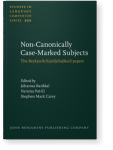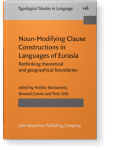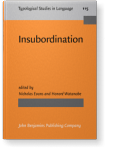Zaira Khalilova
List of John Benjamins publications for which Zaira Khalilova plays a role.
2021 Chapter 16. Antipassives in Nakh-Daghestanian languages: Exploring the margins of a construction Antipassive: Typology, diachrony, and related constructions, Janic, Katarzyna and Alena Witzlack-Makarevich (eds.), pp. 515–548 | Chapter
Several Nakh-Daghestanian languages present constructions that are candidate antipassives, in that the construction is intransitive and is (at least sometimes) related to a corresponding transitive construction, with A of the transitive construction appearing as S of the intransitive, and P of… read more
2018 Chapter 3. Affective constructions in Tsezic languages Non-Canonically Case-Marked Subjects: The Reykjavík-Eyjafjallajökull papers, Barðdal, Jóhanna, Na'ama Pat-El and Stephen Mark Carey (eds.), pp. 55–82 | Chapter
This article addresses affective (“experiencer”) constructions in the Tsezic languages (Nakh-Daghestanian), which represent the most frequent type of non-canonical subject constructions in these languages. They differ from transitive constructions in a number of ways that go far beyond case marking… read more
2017 General noun-modifying clause constructions in Hinuq and Bezhta, with a note on other Daghestanian languages Noun-Modifying Clause Constructions in Languages of Eurasia: Rethinking theoretical and geographical boundaries, Matsumoto, Yoshiko, Bernard Comrie and Peter Sells (eds.), pp. 121–146 | Article
Hinuq and Bezhta, two languages of the Tsezic sub-group of the Nakh-Daghestanian (East Caucasian) language family, have General noun modifying clause constructions (GNMCCs), which have also been noted in some other Nakh-Daghestanian languages. While readily acceptable and interpretable, GNMCCs that… read more
2016 Chapter 7. Insubordination in the Tsezic Languages Insubordination, Evans, Nicholas and Honoré Watanabe (eds.), pp. 171–182 | Article
The Tsezic languages present a number of prima facie instances of insubordination, given current definitions of this phenomenon. For the purposes of this chapter, we base ourselves on the definition provided by Evans (2007: 367): “[Insubordination is] the conventionalized main clause use of what,… read more



